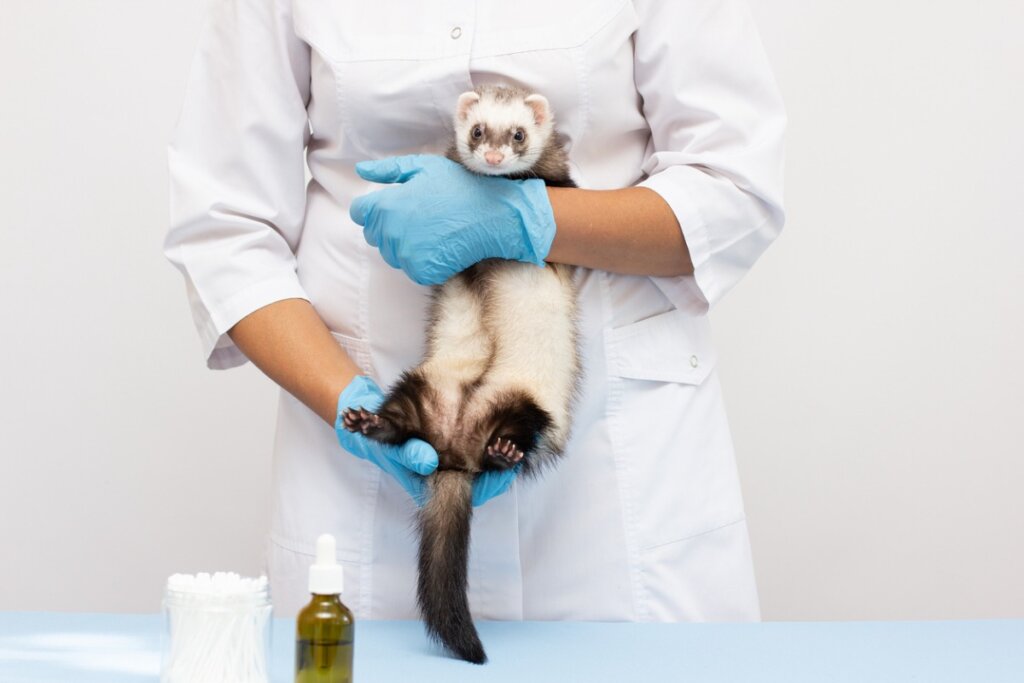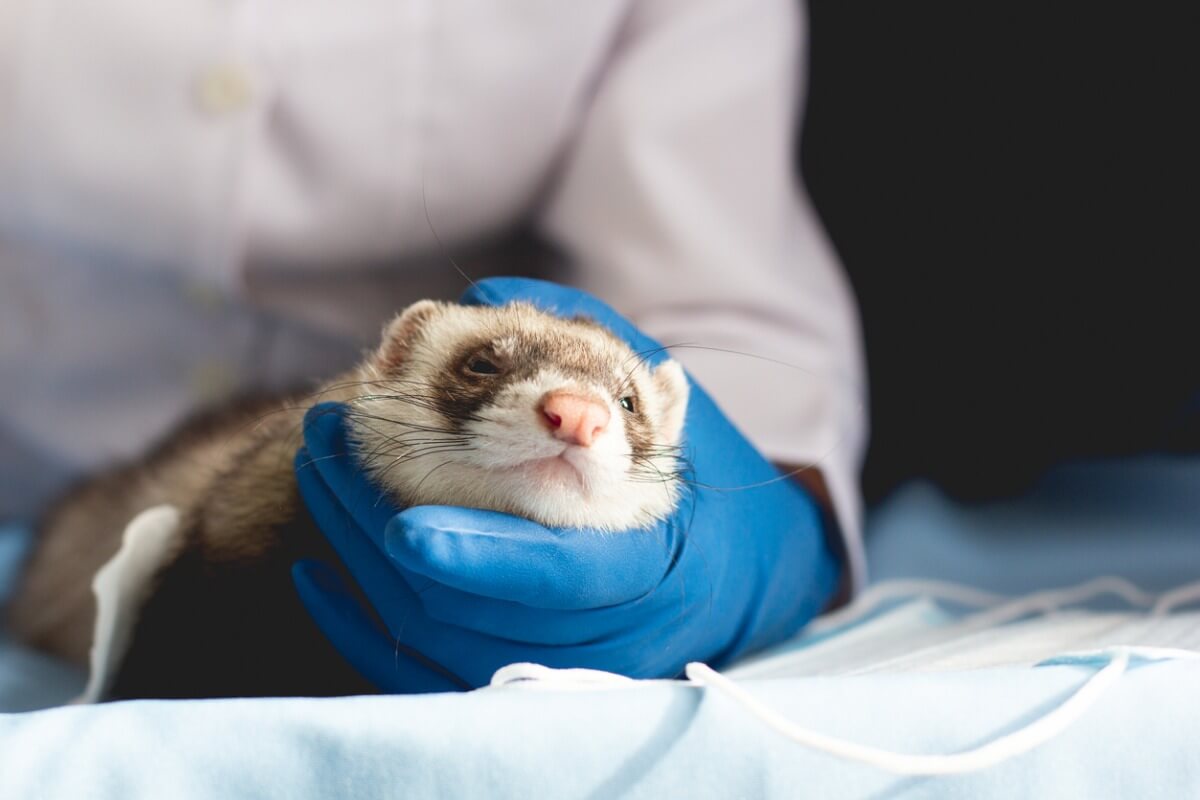Dilated Cardiomyopathy in Ferrets

Dilated cardiomyopathy in ferrets is the most commonly diagnosed heart condition in these animals. This disease is characterized by progressive loss of contractility of the heart, resulting in a number of fairly generic clinical signs, such as listlessness, loss of appetite, and lethargy. It can be easily confused with the effects of aging, but it’s a pathological condition.
Dilated cardiomyopathy is just one of the many common conditions in ferrets. You should go to the vet as soon as you notice certain specific symptoms in your ferret, so read on. Here’s how to detect heart failure in your pet before it’s too late.
What’s dilated cardiomyopathy?
The term dilated cardiomyopathy is used in vertebrates to describe a specific disease of the heart muscle. In this condition, there’s stretching and reduced strength in the myocardium (heart muscle tissue), which makes it more difficult for the heart to move blood throughout the body. As a result, some tissues no longer receive the number of nutrients and O₂ they require.
Dilated cardiomyopathy is the most common cardiac and circulatory pathology in adult ferrets, along with acquired valvular pathologies and certain types of arrhythmias. On the other hand, myocarditis, infectious diseases of the heart, endocarditis, and heart neoplasms are considered to have a low incidence in these mustelids.
This condition is more common in adult ferrets over 4 years of age (especially considering that their average life expectancy is between 5 and 10 years). On the other hand, there is no bias towards either sex. Males and females are equally prone to cardiomyopathy.
Over time, the weakening of the heart can lead to sudden heart failure. It also leads to vascular problems, arrhythmias (irregular heartbeat), and severe thrombosis. The animal must be diagnosed promptly, as this condition is considered a medical emergency.
As the musculature of the heart becomes fragile, the heart dilates and stops pumping blood as strongly as it should.

Causes of dilated cardiomyopathy in ferrets
The cause of dilated cardiomyopathy in ferrets is unknown. In domestic cats, the weakening of the heart muscle has been found to be associated with a lack of amino acids in the diet (specifically taurine), but this doesn’t appear to be true in ferrets. However, a possible dietary origin can’t be ruled out.
This condition is much more common in older ferrets, so it’s often attributed to age.
Symptoms
Most ferrets under 2 years of age don’t show signs of dilated cardiomyopathy. However, cardiac damage slowly and steadily worsens over time, causing a number of non-specific signs to appear in the animal. Among them, we can highlight the following:
- Sinus tachycardias: The normal beats per minute in this species are between 180 and 250, but, in a DCM condition, they can increase above 250.
- Faster than normal breathing and breathing difficulties.
- Bluish gums: Tissues become bluish or cyanotic from lack of oxygen due to heart failure.
- Loss of appetite and anorexia.
- General listlessness
- Fluid accumulation in the chest and abdomen (swelling).
Unfortunately, the aforementioned symptoms usually don’t appear until the heart already shows considerable damage. Therefore, treatment of the pet is difficult at this point.
Diagnosis
Once at the clinic, the veterinarian will perform a general physical examination of the ferret. This includes listening for heart rhythm and abnormal breath sounds with a stethoscope. However, a superficial examination won’t allow a differential diagnosis to be made.
Thoracic radiographs are very useful in detecting conditions such as this, as they allow an assessment of the size of the heart and any damage it may have suffered over time. On the other hand, echocardiography makes it possible to observe in real time how the myocardium pumps blood, which is an indication of the general condition of the heart.
Unfortunately, not all veterinarians have access to these types of diagnostic tests and they’re quite expensive.
Treatment of dilated cardiomyopathy in ferrets
This condition is considered a medical emergency and the ferret should be treated appropriately and according to its needs as soon as it’s diagnosed. The clinical approach has two specific purposes: to make the animal’s heart distribute blood better throughout the body and to reduce the amount of fluid that has accumulated in the thorax and abdomen.
To achieve the reduction of accumulated fluids, the veterinarian will prescribe diuretic drugs to facilitate urination. On the other hand, digoxin and enalapril are useful to help improve circulation by increasing the contractile capacity of the heart and decreasing the resistance offered by the blood vessels.
Standard doses are 0.005-0.01 milligrams of digoxin per kilogram of the animal every 12-24 hours and 0.25-0.5 milligrams of enalapril per kilogram in the same time interval. Some ferrets don’t react well to the latter, so they should be monitored.

Prognosis and home care
The prognosis for dilated cardiomyopathy is variable, as most ferrets only begin to show signs when the cardiac damage is already irreversible. However, an acceptable quality of life can be maintained with changes in diet and the administration of prescribed drugs.
For example, it’s recommended that the affected ferret be given a low sodium diet, which will decrease fluid retention. It’s also appropriate to give a low-fat diet (especially if the animal is obese), as it will have some reluctance to move and burn calories. If you follow the doctor’s instructions, your pet’s quality of life will be good in the time it has left to live.
All cited sources were thoroughly reviewed by our team to ensure their quality, reliability, currency, and validity. The bibliography of this article was considered reliable and of academic or scientific accuracy.
- Manejo clínico de la cardiomiopatía dilata en hurones, Portal Veterinaria (PV). Recogido a 1 de noviembre en https://www.portalveterinaria.com/animales-de-compania/articulos/23135/manejo-clinico-de-la-cardiomiopatia-dilatada-en-hurones.html
- Cardiomyopathy in ferrets, Wag! Recogido a 1 de noviembre en https://wagwalking.com/ferret/condition/dilated-cardiomyopathy
- Dilated Cardiomyopathy in Ferrets (Heart Failure, Congestive Heart Disease), Pet Place. Recogido a 1 de noviembre en https://www.petplace.com/article/small-mammals/general/dilated-cardiomyopathy-in-ferrets-heart-failure-congestive-heart-disease/
- CARDIOMIOPATÍA DILATADA – HURON, Vetnatura. Recogido a 1 de noviembre en http://www.vetnatura.es/articulo.asp?a=242&t=cardiomiopat%C3%ADa-dilatada-huron
